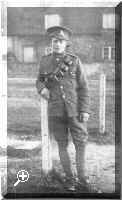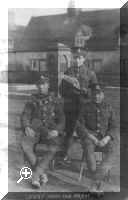The First World War
 The
Bury Free Press of September 12th. 1914, reported that the residents of
Tuddenham had passed a resolution to be ' ready to do all that Lord Kitchener
asks' and 'welcomed organized military training for all people
The
Bury Free Press of September 12th. 1914, reported that the residents of
Tuddenham had passed a resolution to be ' ready to do all that Lord Kitchener
asks' and 'welcomed organized military training for all people .
.
A month earlier Reservist Harry Scott of the King's Own Rifles had already
left for duty. At 29 years of age he left his 26 year old wife Nellie and two
young children living at Charity Farm. Away for the duration of the war Harry
returned by train to Higham station and walked home to Tuddenham. A farm
labourer working in the fields noticed him and ran to the farm calling, '
Nellie, Nellie, there's a soldier come over the hill '. Nellie left the stone
slabs of the kitchen floor half scrubbed, put her hair up into a bun and ran to
meet him, then, in her own words, they 'shook hands'.
During World War 1 the soldiers hired the village school for five shillings a
night to hold military dances. Fifty troopers of the Royal Garrison Artillery
were billeted in the school overnight on November 8th. 1915 and the rector
authorized its closure due to the 'foul atmosphere' .
.
The headmaster, George French-Matthews kept a school log book and recorded
Zeppelin raids over the village. One raid on February 1st. 1916 that 'badly
shook the village houses' dropped 60 bombs in the area and lasted from 7.25 p.m.
until 9.40.p.m .
.
 Among
at least five men from the village who died in 1917 on the 'poppy fields of
Flanders' was Spencer George Grimwood, whose headstone in the village churchyard
is still tended by the War Graves Commission.Spencer died from his wounds in a
military hospital in London and his coffin, draped with the Union Jack, was
conveyed to Tuddenham from Mildenhall railway station in a glass panelled
hearse.
Among
at least five men from the village who died in 1917 on the 'poppy fields of
Flanders' was Spencer George Grimwood, whose headstone in the village churchyard
is still tended by the War Graves Commission.Spencer died from his wounds in a
military hospital in London and his coffin, draped with the Union Jack, was
conveyed to Tuddenham from Mildenhall railway station in a glass panelled
hearse.
Lance Corporal Henry Nunn died of pneumonia after three months in the
trenches. He was clerk in the estate offices of Mr. A.B.H. Goldschmidt of
Cavenham and Mr. Leopold Davies of Herringswell.
Sgt. Edward Hollock Smith married Ada Woollard from Nod's Hall on September
26th. 1915 just prior to him being sent to France. He was killed in action on
July 13th. 1917 and was awarded the Military Medal which was presented to his
widow during a ceremony at Mildenhall .
.
Of the eighty men mentioned on the Roll of Honour posted in the village
church nine lost their lives. Among the men that went to 'do their duty' were
the village shoemaker, postman, coalman, baker, blacksmith, builder and many
agricultural workers. The population of the village in 1911 was 318 illustrating
the fact that one quarter of the village served away from home during the First
World War.
©2000 Susan Cook